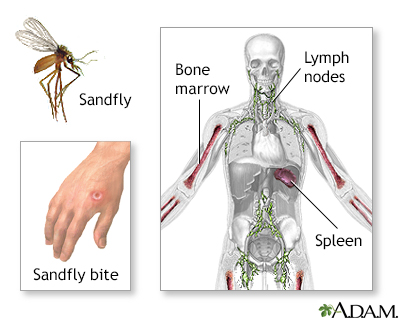Leishmaniasis
Kala-azar; Cutaneous leishmaniasis; Visceral leishmaniasis; Old world leishmaniasis; New world leishmaniasis
Leishmaniasis is an infectious disease spread by the bite of the female sandfly.

Leishmaniasis is a parasitic disease spread by the bite of the sandfly and can cause skin disease and systemic disease. The systemic form can be fatal, but treatment with antimony-containing compounds produces a high cure rate.

Parasites are deposited in the skin by the bite of a sand-fly. These parasites (leishmania) produce a local sore at the site of the bite and migrate throughout the body, causing tissue destruction at distant sites.

Leishmaniasis is seen in the United States mainly in people who have traveled outside the U.S. There are several different types of leishmaniasis, but all are transmitted by the bite of a sandfly. An initial sore develops at the site of the bite, as shown here. The infection may spread through the body from that point.

Leishmaniasis is seen in the United States mainly in people who have traveled outside the U.S. There are several different types of leishmaniasis, but all are transmitted by the bite of a sandfly. An initial sore develops at the site of the bite, as shown here. The infection may spread through the body from that point.

Leishmaniasis is seen in the United States mainly in people who travel outside the U.S. There are several different types of leishmaniasis, but all are transmitted by the bite of a sandfly. This is the typical appearance of the early stage of leishmaniasis.
Causes
Leishmaniasis is caused by a tiny parasite called leishmania protozoa. Protozoa are one-celled organisms.
The different forms of leishmaniasis are:
- Cutaneous leishmaniasis affects the skin and mucous membranes. Skin sores usually start at the site of the sandfly bite. In a few people, sores may develop on mucous membranes.
- Systemic, or visceral, leishmaniasis affects the entire body. This form occurs 2 to 8 months after a person is bitten by the sandfly. Most people do not remember having a skin sore. This form can lead to deadly complications. The parasites damage the immune system by decreasing the numbers of disease-fighting cells.
Cases of leishmaniasis have been reported on all continents except Australia and Antarctica. In the Americas, the disease can be found in Mexico and South America. It has also been reported in military personnel who have returned from the Persian Gulf.
Symptoms
Symptoms of cutaneous leishmaniasis depend on where the lesions are located and may include:
- Breathing difficulty
- Skin sores, which may become a skin ulcer that heals very slowly
- Stuffy nose, runny nose, and nosebleeds
- Swallowing difficulty
- Ulcers and wearing away (erosion) in the mouth, tongue, gums, lips, nose, and inner nose
Systemic visceral infection in children usually begins suddenly with:
- Cough
- Fever
Adults usually have a fever for 2 weeks to 2 months, along with symptoms such as fatigue, weakness, and appetite loss. Weakness increases as the disease gets worse.
Other symptoms of systemic visceral leishmaniasis may include:
- Abdominal discomfort
- Fever that lasts for weeks; may come and go in cycles
- Night sweats
- Scaly, gray, dark, ashen skin
- Thinning hair
- Weight loss
Exams and Tests
Your health care provider will examine you and may find that your spleen, liver, and lymph nodes are enlarged. You will be asked if you recall being bitten by sandflies or if you've been in an area where leishmaniasis is common.
Tests that may be done to diagnose the condition include:
- Biopsy of the spleen and culture
- Bone marrow biopsy and culture
- Direct agglutination assay
- Indirect immunofluorescent antibody test
- Leishmania-specific PCR test
- Liver biopsy and culture
- Lymph node biopsy and culture
- Montenegro skin test (not approved in the United States)
- Skin biopsy and culture
Other tests that may be done include:
- Complete blood count with differential
- Serologic testing
- Serum albumin
- Serum immunoglobulin levels
- Serum protein
Treatment
Antimony-containing compounds are the main medicines used to treat leishmaniasis. These include:
- Meglumine antimoniate
- Sodium stibogluconate
Other medicines that may be used include:
- Amphotericin B
- Ketoconazole
- Miltefosine
- Paromomycin
- Pentamidine
Plastic surgery may be needed to correct the disfigurement caused by sores on the face (cutaneous leishmaniasis).
Outlook (Prognosis)
Cure rates are high with the proper medicine, mostly when treatment is started before it affects the immune system. Cutaneous leishmaniasis may lead to disfigurement.
Death is usually caused by complications (such as other infections), rather than from the disease itself. Death often occurs within 2 years.
Possible Complications
Leishmaniasis may lead to the following:
- Bleeding (hemorrhage)
- Deadly infections due to immune system damage
- Disfigurement of the face
When to Contact a Medical Professional
Contact your provider if you have symptoms of leishmaniasis after visiting an area where the disease is known to occur.
Prevention
Taking measures to avoid sandfly bites can help prevent leishmaniasis:
- Putting fine mesh netting around the bed (in areas where the disease occurs)
- Screening windows
- Wearing insect repellent
- Wearing protective clothing
Public health measures to reduce sandflies are important. There are no vaccines or medicines that prevent leishmaniasis.
References
Aronson NE, Copeland NK, Magill AJ. Leishmania species: visceral (kala-azar), cutaneous, and mucosal leishmaniasis. In: Bennett JE, Dolin R, Blaser MJ, eds. Mandell, Douglas, and Bennett's Principles and Practice of Infectious Diseases. 9th ed. Philadelphia, PA: Elsevier; 2020:chap 275.
Dinulos JGH. Infestations and bites. In: Dinulos JGH, ed. Habif's Clinical Dermatology. 7th ed. Philadelphia, PA: Elsevier; 2021:chap 15.
Version Info
Last reviewed on: 8/26/2023
Reviewed by: Jatin M. Vyas, MD, PhD, Associate Professor in Medicine, Harvard Medical School; Associate in Medicine, Division of Infectious Disease, Department of Medicine, Massachusetts General Hospital, Boston, MA. Also reviewed by David C. Dugdale, MD, Medical Director, Brenda Conaway, Editorial Director, and the A.D.A.M. Editorial team.
